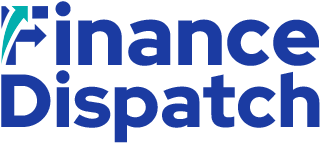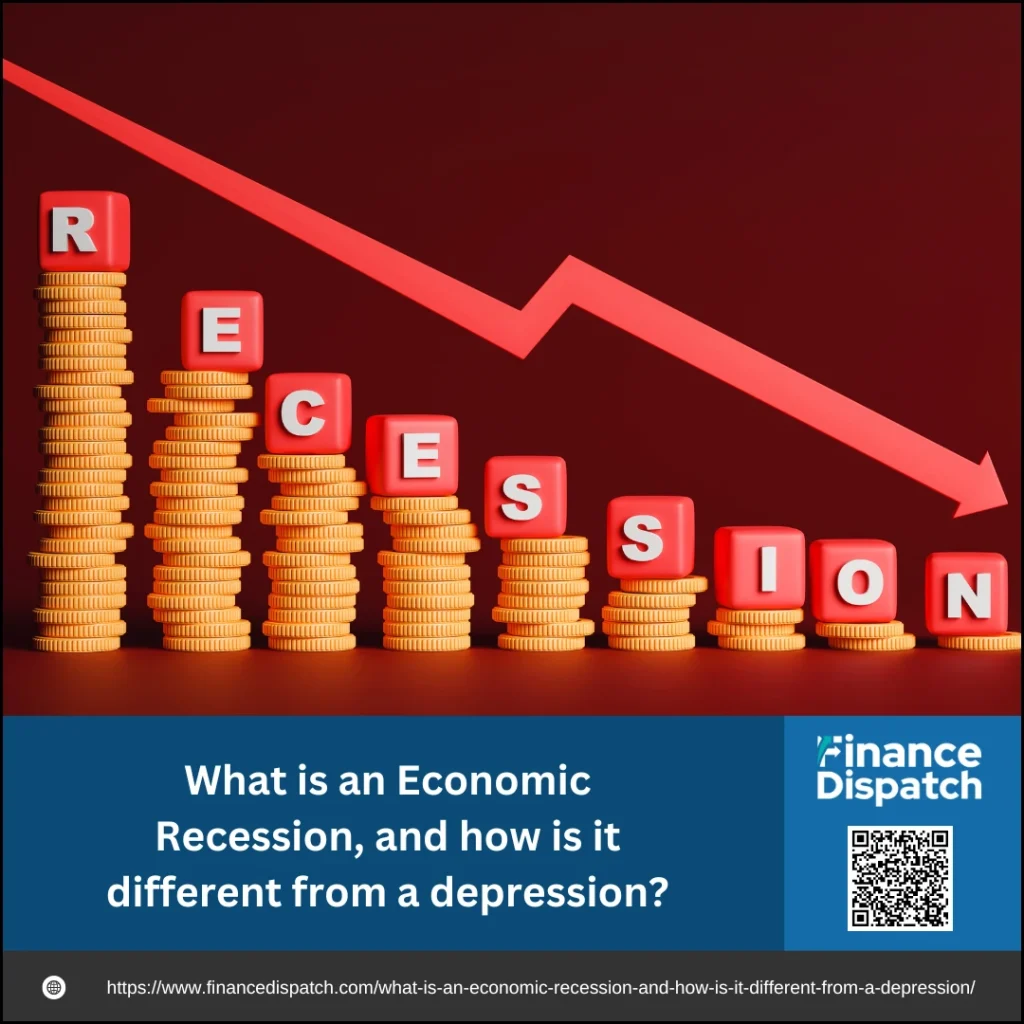Economic downturns are an inevitable part of the financial cycle, but not all downturns are created equal. The terms “recession” and “depression” are often used interchangeably, yet they represent vastly different levels of economic hardship. A recession is a temporary decline in economic activity, typically lasting a few months to a couple of years, while a depression is a prolonged and more severe economic collapse that can last for several years. Understanding the differences between the two is crucial for individuals, businesses, and policymakers to navigate financial uncertainty and prepare for potential economic challenges. This article explores the key characteristics of recessions and depressions, their causes, impacts, and historical examples to provide a clear distinction between these two economic phases.
What is an Economic Recession?
An economic recession is a period of significant decline in economic activity across multiple sectors, typically lasting for at least a few months. It is often recognized by a drop in gross domestic product (GDP) for two consecutive quarters, though economists use broader indicators such as rising unemployment rates, declining industrial production, reduced consumer spending, and lower business investments to define a recession. Recessions are a natural part of the business cycle, occurring after periods of economic expansion when demand slows down, businesses cut back on production, and financial markets experience uncertainty. While recessions can be challenging, they are generally temporary, and economies tend to recover as governments and central banks implement policies to stimulate growth and restore financial stability.
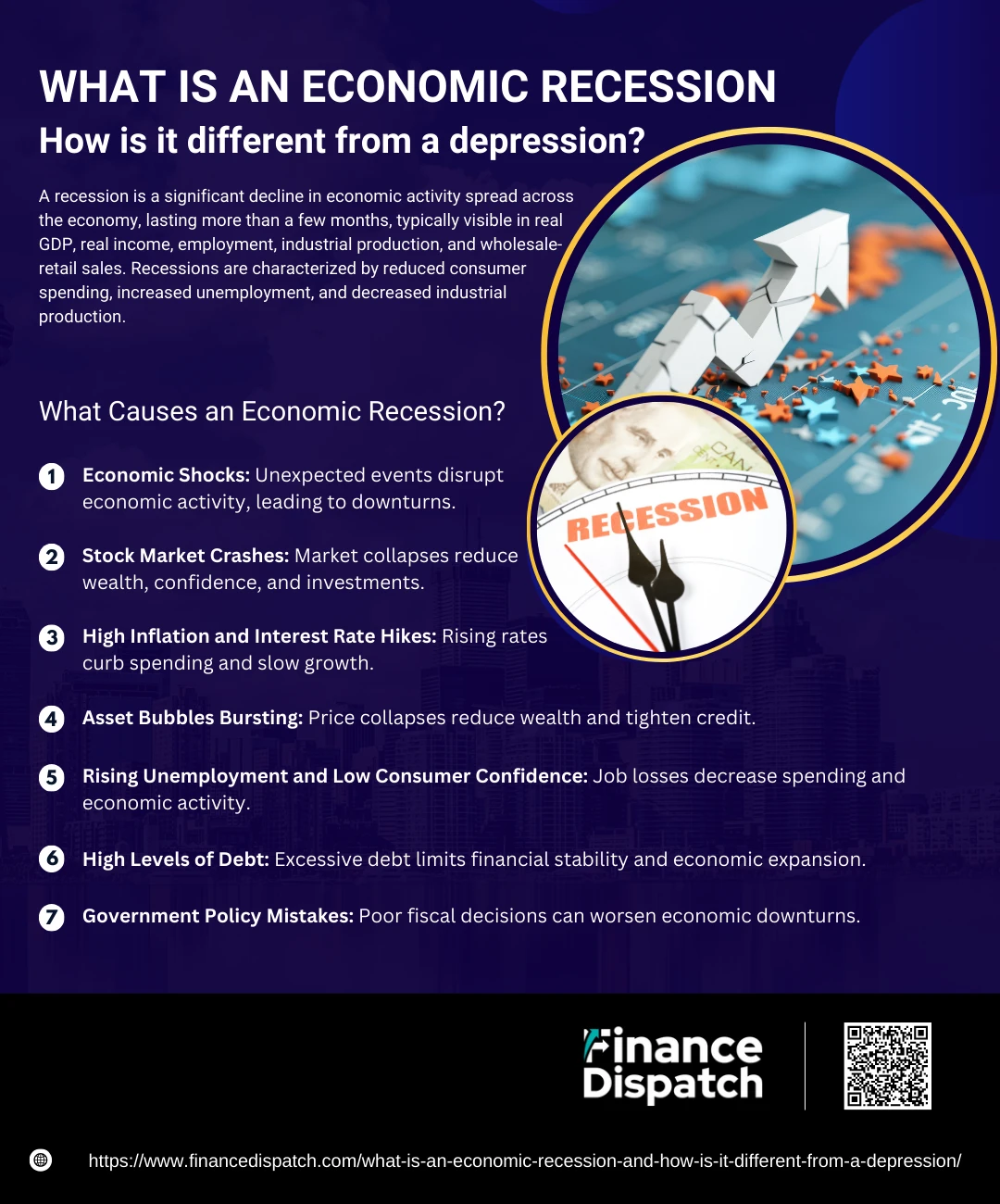 What Causes an Economic Recession?
What Causes an Economic Recession?
Economic recessions can be triggered by various factors, ranging from financial market disruptions to external shocks like natural disasters or global pandemics. While each recession has unique causes, they typically stem from imbalances in the economy, shifts in consumer and business confidence, or policy changes. Below are some of the most common causes of economic recessions.
1. Economic Shocks
Unexpected events like the COVID-19 pandemic or oil price shocks can disrupt economic activity, causing businesses to shut down and consumers to cut spending, leading to a recession.
2. Stock Market Crashes
A major stock market collapse can wipe out wealth, reduce investor confidence, and lead to a decline in spending and investments, triggering an economic downturn.
3. High Inflation and Interest Rate Hikes
When inflation rises too fast, central banks increase interest rates to control it. Higher interest rates make borrowing more expensive, reducing consumer and business spending, which can slow economic growth and lead to a recession.
4. Asset Bubbles Bursting
When asset prices (such as housing or tech stocks) rise rapidly beyond their true value, they form a bubble. If the bubble bursts, investors lose money, banks tighten lending, and the economy contracts. The 2008 financial crisis was a classic example.
5. Rising Unemployment and Low Consumer Confidence
When businesses anticipate a slowdown, they cut jobs, leading to rising unemployment. As people lose income, they spend less, which further weakens economic activity and can push the economy into a recession.
6. High Levels of Debt
Excessive corporate or consumer debt can strain financial institutions. If too many borrowers default on loans, banks reduce lending, making it harder for businesses and individuals to spend and invest, slowing down the economy.
7. Government Policy Mistakes
Poor fiscal policies, such as excessive government spending or sudden tax hikes, can strain economic growth. Similarly, failing to act in time to address warning signs of an economic downturn can worsen a recession.
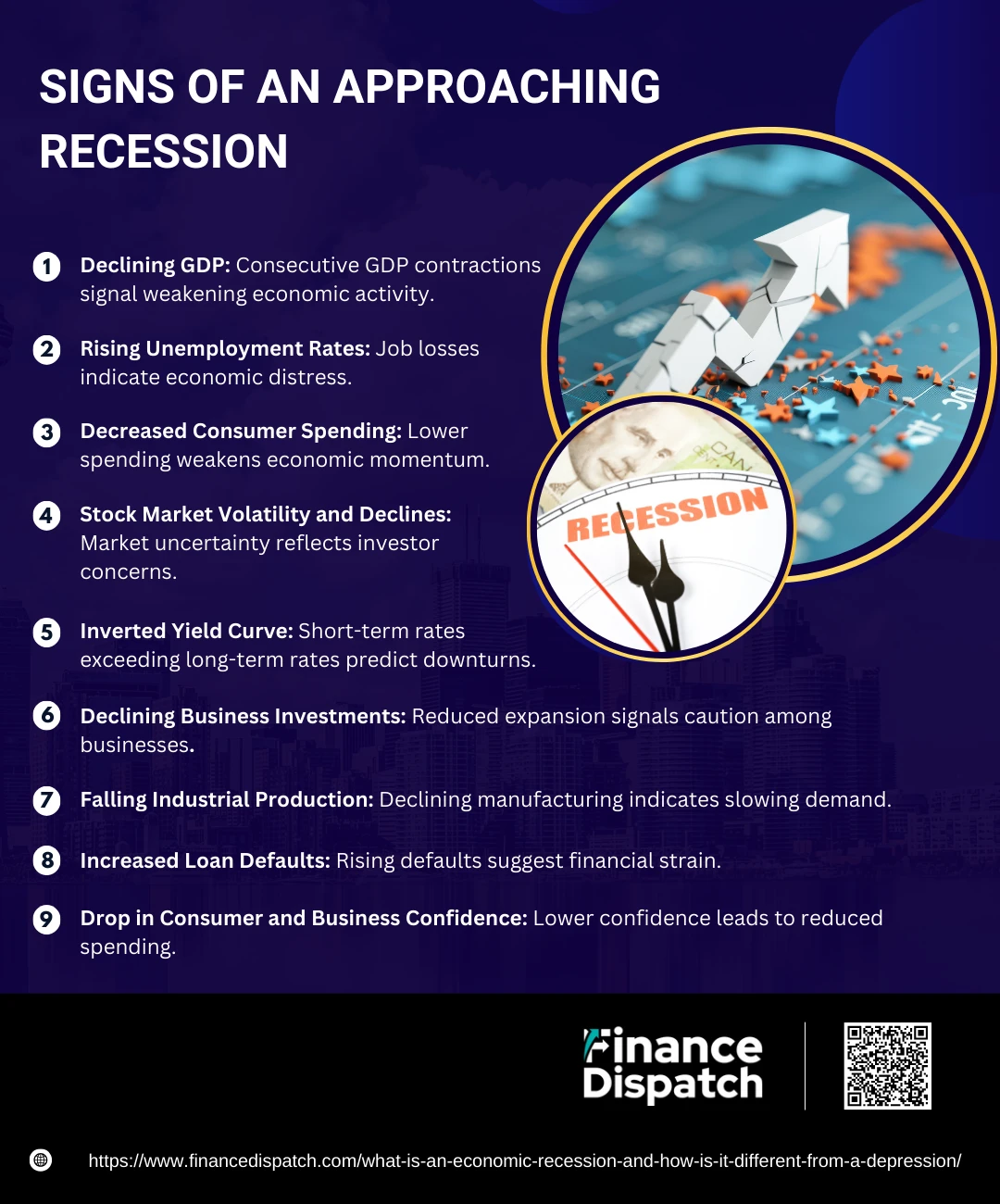 Signs of an Approaching Recession
Signs of an Approaching Recession
Economic downturns rarely happen overnight; they develop gradually as key indicators start to weaken. While recessions are a natural part of the economic cycle, early warning signs can help businesses, investors, and policymakers take proactive steps to mitigate their impact. By closely monitoring economic data, it’s possible to identify patterns that signal an approaching recession. Below are some of the most common warning signs.
- Declining Gross Domestic Product (GDP): A slowdown or contraction in GDP over consecutive quarters suggests weakening economic activity and is a primary indicator of a looming recession.
- Rising Unemployment Rates: When businesses expect lower demand, they start cutting jobs. A steady rise in unemployment rates signals economic distress.
- Decreased Consumer Spending: Consumer spending drives a significant portion of the economy. A noticeable decline in retail sales, housing purchases, and discretionary spending can indicate weakening confidence.
- Stock Market Volatility and Declines: Frequent stock market drops and increased volatility often reflect investor uncertainty about future economic growth.
- Inverted Yield Curve: When long-term interest rates fall below short-term rates, it suggests investors are losing confidence in the economy’s long-term prospects, a well-known recession predictor.
- Declining Business Investments: Businesses reduce expansion, hiring, and capital spending when they anticipate a downturn, leading to slower economic growth.
- Falling Industrial Production and Manufacturing Output: A decline in factory orders and manufacturing activity signals weakening demand and slower economic momentum.
- Increased Loan Defaults and Tightening Credit Conditions: Higher delinquency rates on mortgages, auto loans, and credit cards suggest financial stress among consumers, while banks tightening lending indicates concerns about economic stability.
- Drop in Consumer and Business Confidence: Surveys measuring confidence levels often decline before a recession, as uncertainty causes individuals and companies to hold off on spending and investment.
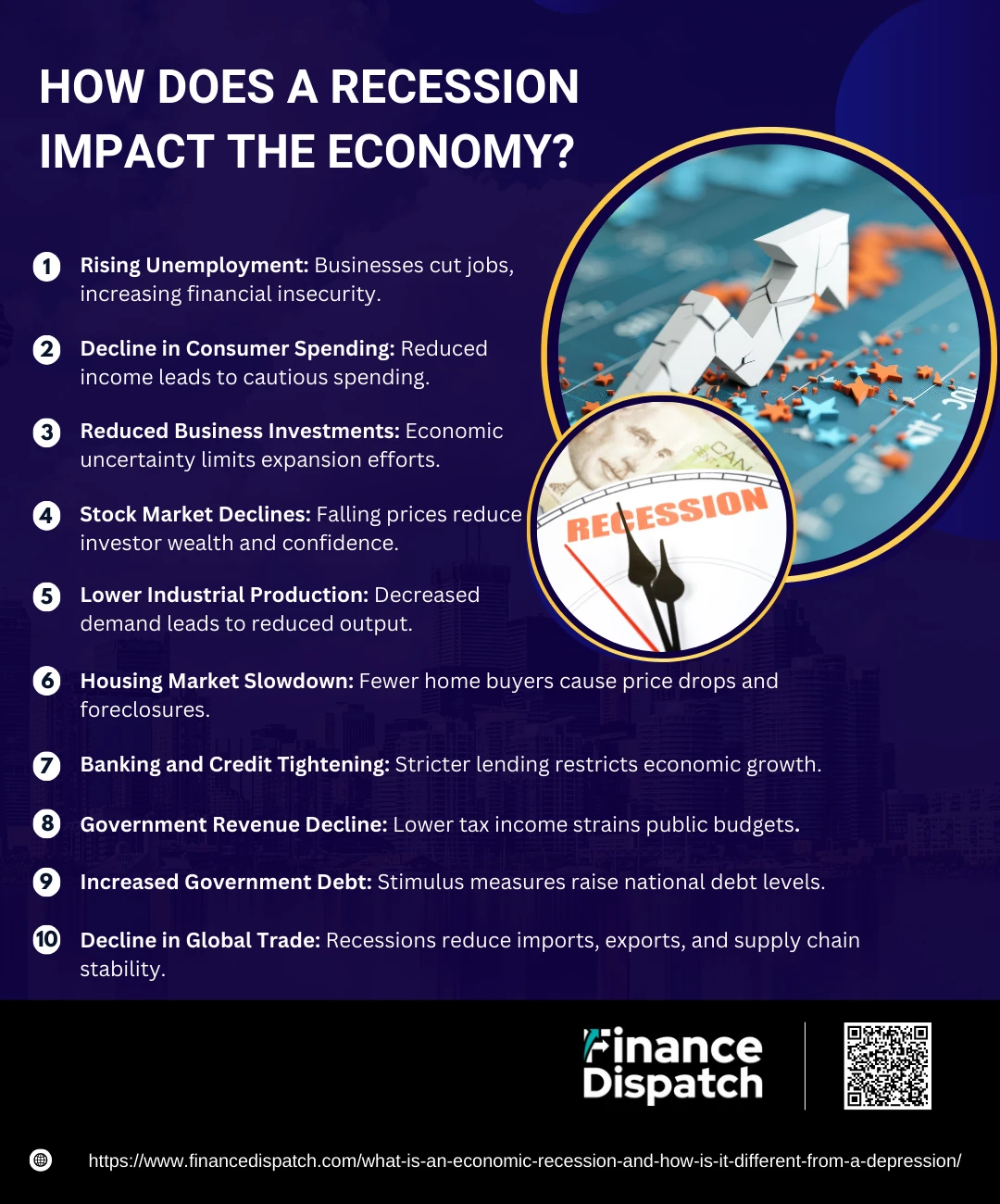 How Does a Recession Impact the Economy?
How Does a Recession Impact the Economy?
A recession can have widespread and long-lasting effects on an economy, disrupting businesses, employment, and financial stability. As economic activity slows, companies struggle with declining revenues, individuals face job losses, and governments experience budget shortfalls. While recessions are a natural part of the economic cycle, their impact can vary in severity depending on the underlying causes and how governments and central banks respond. Below are some of the key ways a recession affects different aspects of the economy.
1. Rising Unemployment
One of the most immediate and visible effects of a recession is job loss. Businesses facing declining revenues often reduce their workforce to cut costs. Hiring freezes and layoffs increase, making it harder for job seekers to find employment. The longer a recession lasts, the higher unemployment rates rise, leading to financial insecurity for many households.
2. Decline in Consumer Spending
With job uncertainty and reduced income, consumers become more cautious about spending money. Non-essential purchases, such as dining out, travel, and luxury items, decline significantly. Since consumer spending drives a large portion of economic growth, this slowdown further worsens the recession, creating a cycle of reduced demand and lower production.
3. Reduced Business Investments
Companies become hesitant to invest in new projects, research, and expansion due to economic uncertainty. When businesses cut back on investments, it leads to slower technological advancements, fewer job opportunities, and delayed infrastructure improvements. This lack of investment can prolong the recovery process even after the recession ends.
4. Stock Market Declines
A recession typically triggers stock market instability as investors react to declining corporate profits and economic uncertainty. Market volatility increases, and stock prices fall, reducing the value of investments and retirement savings. This can have a cascading effect on consumer confidence, as people see their portfolios shrink, prompting even more cautious financial behavior.
5. Lower Industrial Production
Manufacturing and production industries are particularly vulnerable during recessions. With consumer demand decreasing, companies reduce production, lay off workers, and in some cases, shut down factories. A decline in industrial output also affects suppliers, logistics companies, and related businesses, causing a broader economic slowdown.
6. Housing Market Slowdown
During a recession, the housing market tends to suffer as fewer people can afford to buy homes, and banks become more cautious about lending. Home prices may decline due to decreased demand, and homeowners facing financial struggles may default on their mortgages, leading to an increase in foreclosures. A sluggish housing market can take years to recover fully.
7. Banking and Credit Tightening
Financial institutions become more risk-averse during economic downturns, tightening lending standards. This means businesses and individuals may struggle to get loans for homes, education, or business expansion. Limited access to credit further slows down economic activity and weakens the ability of businesses to recover quickly.
8. Government Revenue Decline
As unemployment rises and businesses make less profit, government tax revenues decline. This leads to budget deficits, forcing governments to either cut public services or increase borrowing to cover expenses. Essential services such as education, healthcare, and infrastructure projects may face funding cuts, affecting overall public well-being.
9. Increased Government Debt
To counteract the effects of a recession, governments often implement stimulus measures such as increased public spending, tax cuts, or direct financial aid to businesses and individuals. While these actions can help stabilize the economy, they often lead to a rise in national debt. Long-term debt accumulation can create challenges for future economic growth and financial stability.
10. Decline in Global Trade
Since economies are interconnected through trade, a recession in one country can affect others. Reduced consumer demand leads to lower imports and exports, slowing global economic activity. Supply chain disruptions may occur as businesses cut production, and multinational companies may struggle to maintain profitability. A global recession can prolong recovery efforts and create lasting financial instability in multiple regions.
What is an Economic Depression?
An economic depression is a prolonged and severe downturn in economic activity that lasts for several years, significantly impacting businesses, employment, and overall financial stability. Unlike a recession, which is a temporary decline in economic activity, a depression is characterized by an extended period of negative gross domestic product (GDP) growth, massive job losses, widespread business closures, and a deep decline in consumer and investor confidence. The most well-known example is the Great Depression (1929-1940s), during which the U.S. economy contracted by nearly 30%, unemployment soared to 25%, and the financial system collapsed. Depressions are rare but highly disruptive, often requiring large-scale government intervention, financial reforms, and significant structural changes in the economy to facilitate recovery. Unlike recessions, which are part of the natural business cycle, depressions result from extreme economic crises, financial mismanagement, or global economic shocks that take years, or even decades, to overcome.
Key Differences between a Recession and a Depression
While both recessions and depressions refer to economic downturns, they differ in severity, duration, and overall impact on the economy. A recession is a temporary decline in economic activity, typically lasting a few months to a couple of years, whereas a depression is a more prolonged and severe economic collapse that can last for several years. Recessions are common in the business cycle and often corrected by monetary and fiscal policies, whereas depressions require extensive government intervention and structural economic reforms. Below is a table highlighting the key differences between the two.
Comparison of Recession and Depression
| Factor | Recession | Depression |
| Definition | A significant decline in economic activity that lasts for a few months to a couple of years. | A prolonged and severe economic downturn lasting several years. |
| Duration | Typically 6 months to 2 years. | Often lasts more than 3 years, sometimes over a decade. |
| GDP Decline | GDP contracts by less than 10%. | GDP contracts by 10% or more. |
| Unemployment Rate | Moderate increase in job losses, often reaching 8-10%. | Unemployment soars to 25% or higher, leading to long-term joblessness. |
| Stock Market Impact | Stock market declines but recovers relatively quickly. | Major stock market crash with long-term stagnation. |
| Consumer Confidence | Declines temporarily but rebounds as the economy recovers. | Remains severely low for an extended period, affecting spending and investments. |
| Business Closures | Some businesses close or reduce operations, but many survive. | Widespread business failures, bankruptcies, and industrial collapses. |
| Banking System | Some financial distress, but the banking system remains mostly stable. | Widespread bank failures and financial system collapse, often requiring major government intervention. |
| Government Response | Monetary policies (lower interest rates, stimulus packages) help restore growth. | Large-scale economic reforms, extensive public works programs, and financial system restructuring required. |
| Frequency | Occurs periodically as part of the natural business cycle. | Extremely rare, with only one major depression (Great Depression of 1929) in modern history. |
| Impact on Global Trade | Trade slows down but recovers once the recession ends. | Global trade plummets, leading to long-lasting economic stagnation worldwide. |
Real-World Examples of Recessions and Depressions
Throughout history, economies have faced downturns that vary in severity and duration. While recessions are temporary economic declines that last months or a few years, depressions are far more severe and prolonged, causing widespread financial hardship. Below are some key examples of both.
Notable Recessions
- The Great Recession (2008-2009): Triggered by the U.S. housing market collapse, leading to bank failures, job losses, and a global financial crisis.
- COVID-19 Recession (2020): Caused by pandemic-related lockdowns, resulting in historic unemployment and GDP decline.
- The Dot-Com Bubble (2001): A stock market crash fueled by overinvestment in tech startups, leading to corporate bankruptcies.
- Oil Crisis Recession (1973-1975): OPEC’s oil embargo caused high inflation and economic slowdown.
- Early 1980s Recession (1981-1982): The U.S. Federal Reserve’s high-interest rates to curb inflation led to economic contraction.
Notable Depressions
- The Great Depression (1929-1940s): The worst economic crisis in modern history, triggered by the 1929 stock market crash, leading to mass unemployment and global economic collapse.
- The Long Depression (1873-1896): A prolonged period of bank failures, deflation, and industrial decline.
- The Panic of 1837 (1837-1842): Banking failures and land speculation collapse led to severe financial distress in the U.S.
- Argentina’s Great Depression (1998-2002): Debt defaults and currency devaluation led to years of economic instability.
How Do Governments and Economists Manage a Recession?
When a recession occurs, it can lead to job losses, reduced business activity, and financial instability. To counter these negative effects, governments and economists implement strategic policies to stimulate economic growth, restore consumer confidence, and prevent long-term economic damage. These policies involve monetary and fiscal tools, direct financial interventions, and regulatory adjustments to stabilize the economy. Below are the key strategies used to manage and mitigate the effects of a recession.
1. Lowering Interest Rates
One of the first steps taken during a recession is reducing interest rates. Central banks, such as the Federal Reserve in the U.S., lower the cost of borrowing to encourage businesses and consumers to take loans, invest, and spend more. Lower interest rates make mortgages, car loans, and business loans more affordable, boosting economic activity.
2. Increasing Government Spending
Governments often introduce stimulus programs to boost demand and create jobs. Investments in infrastructure projects, public services, and social programs inject money into the economy, leading to job creation and increased consumer spending. Examples include road construction, education programs, and healthcare funding, which generate employment and improve public services simultaneously.
3. Providing Direct Financial Aid
During severe recessions, governments provide stimulus checks, unemployment benefits, and financial aid to individuals and struggling businesses. This helps maintain consumer spending power, preventing a deep economic downturn. For instance, during the COVID-19 recession in 2020, many countries provided direct cash payments and extended unemployment benefits to help people cover essential expenses.
4. Tax Cuts and Incentives
Reducing taxes on individuals and businesses puts more money into circulation, encouraging spending, hiring, and investment. Tax incentives, such as small business grants, tax credits for job creation, and deductions for capital investments, help companies maintain operations and expand even during economic downturns.
5. Supporting Failing Industries
In some cases, specific industries are hit harder than others. Governments may provide bailouts to prevent mass layoffs and economic collapse. During the 2008 financial crisis, major banks and automakers received government assistance to stabilize the economy. Without these bailouts, millions of jobs could have been lost, leading to an even deeper recession.
6. Strengthening the Banking System
A financial crisis can make people lose confidence in the banking system. Governments and central banks take action by increasing deposit insurance, offering emergency loans to banks, and enforcing stricter financial regulations. These measures ensure that banks remain stable, preventing bank failures and protecting people’s savings.
7. Encouraging International Trade and Investment
Recessions can slow down global trade, impacting businesses that rely on imports and exports. Governments may negotiate trade deals, reduce tariffs, or provide incentives for foreign investments to keep international markets open. This helps businesses remain competitive and keeps the economy connected to global supply chains.
8. Controlling Inflation and Deflation
During a recession, inflation (rising prices) or deflation (falling prices) can create additional economic instability. Governments and central banks adjust monetary policies, money supply, and interest rates to stabilize prices. For example, if deflation occurs, lowering interest rates encourages spending and prevents businesses from reducing wages or cutting jobs.
9. Monitoring and Adjusting Economic Policies
Governments and economists continuously analyze economic indicators such as GDP growth, unemployment rates, and consumer spending to adjust policies accordingly. Flexibility in decision-making is crucial because what works in one recession may not work in another. Economists use data-driven approaches to ensure policies remain effective and responsive to changing conditions.
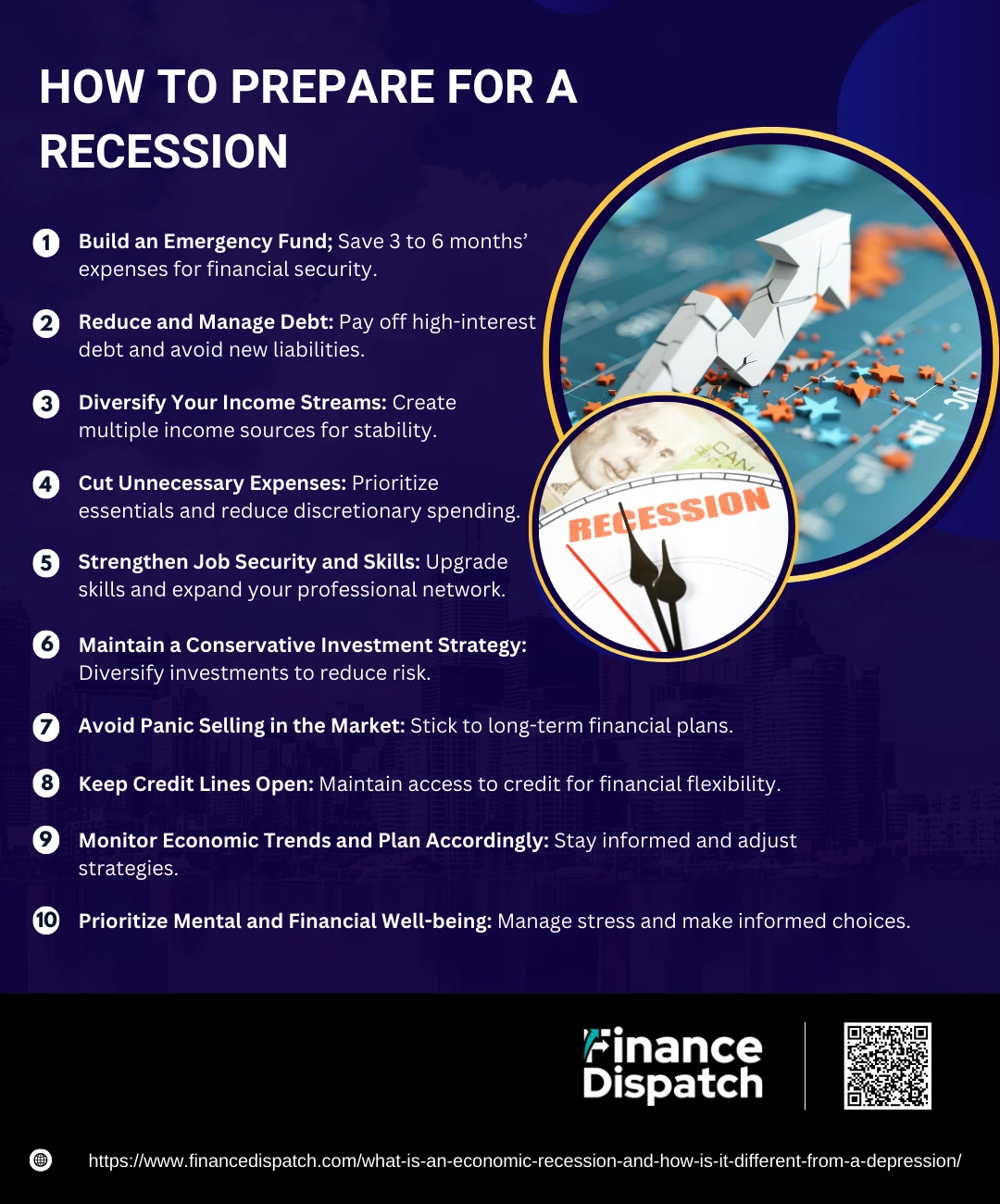 How to Prepare for a Recession
How to Prepare for a Recession
A recession can bring financial uncertainty, job losses, and reduced economic opportunities, making it crucial to prepare in advance. While recessions are part of the economic cycle, individuals, businesses, and investors can take proactive steps to minimize their risks and maintain financial stability. By focusing on saving, reducing debt, diversifying income, and making smart financial choices, you can better navigate economic downturns. Below are key steps to help you prepare for a recession.
1. Build an Emergency Fund
Having 3 to 6 months’ worth of living expenses saved in an emergency fund provides a financial cushion in case of job loss or unexpected expenses. Keep these savings in a high-yield savings account for easy access.
2. Reduce and Manage Debt
High-interest debt, such as credit card balances and personal loans, can become a burden during a recession. Pay down outstanding debts, consolidate loans if necessary, and avoid taking on new, unnecessary debt.
3. Diversify Your Income Streams
Relying on a single source of income can be risky during economic downturns. Consider freelancing, part-time gigs, passive income sources, or side businesses to create financial security.
4. Cut Unnecessary Expenses
Review your spending habits and prioritize essential expenses such as housing, food, and utilities. Reducing discretionary spending on luxuries, subscriptions, and dining out can help free up cash for savings.
5. Strengthen Job Security and Skills
During recessions, companies may downsize. Improve your job skills, update your resume, and expand your professional network to increase your employability. Consider acquiring new certifications or learning in-demand skills.
6. Maintain a Conservative Investment Strategy
Recessions often bring stock market volatility. While investing for the long term is important, ensure your portfolio is diversified across different asset classes, such as bonds, cash, and recession-proof stocks like utilities and healthcare.
7. Avoid Panic Selling in the Market
Market downturns are part of economic cycles. Selling investments out of fear can lead to unnecessary losses. Stick to a long-term financial plan and consider consulting a financial advisor before making major investment decisions.
8. Keep Credit Lines Open
Even if you don’t need it now, having access to a line of credit or personal loan can provide financial flexibility during tough times. Ensure you have a good credit score to qualify for better lending options.
9. Monitor Economic Trends and Plan Accordingly
Stay informed about economic conditions and potential job market shifts. Understanding early recession indicators can help you adjust your financial strategy in advance.
10. Prioritize Mental and Financial Well-being
Economic downturns can be stressful. Having a solid financial plan, support system, and adaptable mindset can help you stay focused and make informed financial choices without panic.
Is It Possible to Prevent Future Recessions?
Completely preventing recessions is nearly impossible because they are a natural part of the economic cycle, driven by fluctuations in consumer demand, business investment, and financial markets. However, governments, central banks, and policymakers can take proactive measures to reduce the frequency and severity of recessions. By implementing sound monetary policies, regulating financial institutions, promoting economic diversification, and encouraging responsible borrowing and lending, economies can become more resilient to downturns. Technological advancements and data-driven economic forecasting also allow policymakers to identify warning signs early and implement preventive strategies before a crisis deepens. While recessions cannot be entirely eliminated, strong fiscal policies, global trade stability, and adaptive economic planning can help minimize their impact and speed up recovery when they do occur.
Conclusion
Recessions are an unavoidable part of the economic cycle, but their impact can be managed through proactive planning, sound financial policies, and strategic interventions by governments and individuals alike. While it may not be possible to prevent all future recessions, early warning systems, responsible financial management, and economic diversification can help mitigate their effects. For individuals and businesses, building financial resilience, reducing debt, and staying informed are key to navigating economic downturns with confidence. By understanding the causes, impacts, and recovery strategies associated with recessions, we can better prepare for economic uncertainties and work toward long-term financial stability and growth.
